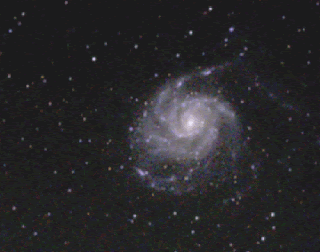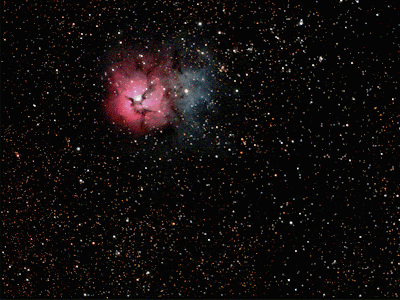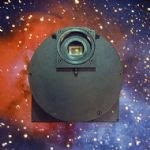
Saturday, June 23, 2007
Friday, June 22, 2007
re: M101, more on the SV115 + SBIG
 This is far, far from the best Pinwheel Galaxy image that you can find online. The image here is a stack of seven x 120 seconds subs, and thus a total exposure of fourteen minutes. I would estimate that at least an hour's worth of exposures are required to really bring out the finer details and beautiful structure of M101.
This is far, far from the best Pinwheel Galaxy image that you can find online. The image here is a stack of seven x 120 seconds subs, and thus a total exposure of fourteen minutes. I would estimate that at least an hour's worth of exposures are required to really bring out the finer details and beautiful structure of M101.All the image processing details are as with the previous image. Here's some of the technical data on the scope and camera from June 19.
The camera was thermoeletrically cooled to 20d Celsius below ambient (which was about 60% of the total cooling capacity available). I used the CCDOPS (SBIG camera control software) autodark feature. Apparently the initial dark frame is subsequently used for calibration of the light frames. That's a huge time saving feature.
The image scale using the StellarVue115 with the .8 TeleVue focal reducer is 2.37 arcseconds/pixel with a 47x63 arcminutes field of view. (I've cropped the M101 image.)
I also tried the CCDOPS track and accumulate feature on two different objects. Unfortunately this feature did not produce usable images, as the "accumulated" stack lacked precise alignment. Over an hour worth of imaging time was wasted on this dead end. After consulting the manual (on the following day), I discovered that track and accumulate is recommended only for relatively short exposures.
Max
Thursday, June 21, 2007
re: the Trifid Nebula
 So here's the first decent image made with the SV115 + the SBIG ST2000-XCM + the CGE + CCDOPS (SBIGs proprietary camera control software) + ImagesPlus + PhotoShop CS2 + lots of trial and error. :)
So here's the first decent image made with the SV115 + the SBIG ST2000-XCM + the CGE + CCDOPS (SBIGs proprietary camera control software) + ImagesPlus + PhotoShop CS2 + lots of trial and error. :)Let me make a long story very short. New equipment means plenty of trial and error testing. After setting up, calibrating, polar aligning, recalibrating, and enrolling in the school of hard knocks, I finally had some usable subs. Of course, the first thing I discovered is that I did not have enough back focus for the SV115 at f/7. The TeleVue .8 focal reducer saved the night. The image that you see is the famous and fabulous M20, the so-called Trifid Nebula, located in that most wonderful of all constellations, Sagittarius!
The composite image is a stack of 15 two minute subs, converted, aligned, and combined and digitally developed in Mike Unsold's ImagesPlus. FYI, for my money, this is absolutely the best investment any imager can make in software. Can't afford PhotoShop? Fine. In fact, why bother with PS? IP will give you everything you need and more in a powerful image processing and camera control program that is, frankly, awesome. Here's a link to the IP page. Mike also participates on a frequent basis in the Yahoo ImagesPlus group.
I'll fill in all the wonky processing data at a later time. But I'm pleased with the results. I've seen better Trifids, of course. But hey, I'm just foolin' around, havin' some fun!
Max
re: new cameras!


The first day of Summer and shortest night of the year has arrived! How I hate nights that have clouds! And I hate nights where it's still light at 9:30 ! Tonight is a double whammy! :) So it goes.
My part of New Mexico has had a long and incredibly cloudy spell...nearly two months. By all indications the monsoon season came very early this year. So I've had lots of time to anguish. And spend money on new gear. A simple fact: at my age, I'm not inclined to wait years before I try to peek at what's over the next mountain. Thus my desire to test modified DSLRs and dedicated CCD imagers.
The upgrades are two. A Hap Griffin modified Canon 350D. More on that camera later, after I have a chance to acquire some photons. And an SBIG ST-2000XCM single shot color camera. A full run down on the SBIG ST-2000XCM can be viewed here.
Believe it or not, I finally caught a night to test the camera! Results will follow in subsequent posts. My initial impressions are: the single shot XCM is one fabulous camera. The self-guide feature alone makes the camera worth the $! (One disappointment: the camera came to me with a big finger print smack in the middle of the optical window. SBIG has not seen fit to offer so much as an apology.)
Two facts convinced me to buy this particular camera. Fact one: I'm not ready to shell out $8K or 9K for the high end, 35mm frame SBIG camera.
Fact two: the image at the top of the page indicates that the single shot XCM performs at a qualitative level across the RGB spectrum to satisfy all but the fussiest of imagers. Maybe a monochrome multi-filter camera awaits me in the future. But for now I'm a "one shot kinda guy!"
Max
Sunday, June 10, 2007
re: data from Mike Reid's pages
Here's an interesting link showing differences in the internal noise (so-called amp glow) between the Canon 350D eight meta-pixel camera and the QHY8 dedicated six mega-pixel camera. Mike is a very accomplished astroimager who has posted a large number of quality images captured with his 350D. You can view his astrophotos here.
The QHY8 is a "storied" camera. There area various threads on Cloudy Nights and elsewhere discussing the camera.
The QHY8 is a "storied" camera. There area various threads on Cloudy Nights and elsewhere discussing the camera.
Saturday, June 2, 2007
re: 1 more 10 min ISO 1600 Xti dark
re: comparison of Canon 350D to Canon 400/Xti
At the bottom of the page you will find links to a page that compares the Canon 350D and the Canon Xti (with occasional data points from the Canon 5D). Please consider the following remarks before proceeding.
Keep in mind that the page is translated by a machine from French into English. There are obviously some substantive issues with translation.
The author (authors?) conclude that the 350 is a better performer for astroimaging than the Xti. Is that true? Well, maybe. And maybe it all depends. I'm the proverbial "man from Missouri" -- so to speak. I'll run my own set of tests over the next few months using my Griffin modified 350 and my unmodified Xti on actual objects. Obviously, the Xti cannot compete with a modified 350 on objects such as M8 and M20. Accordingly I will chose objects for the tests that negate the advantage of a camera with the standard IR filter removed and replacement with a Baader UV/IR block filter. Information on this modification can be found at: http://www.hapg.org/camera%20mods.htm
An issue of some concern to me is the validity of comparative testing based on a single camera of each type. So-called single subject designs can be valid. The 10-minute ISO exposures from last month (see May posts) suggest that despite Canon's quality control and uniformity of production techniques there appears to be variance in performance from chip to chip.
Enough said. Here are the links:
Tiny URL: http://tinyurl.com/y8ws6t
Full URL: http://translate.google.com/translate?u=http%3A%2F%2Fwww.astrosurf.org%2Fbuil%2F400d%2F400d.htm&langpair=fr%7Cen&hl=en&safe=off&ie=UTF-8&oe=UTF-8&prev=%2Flanguage_tools
Max
Keep in mind that the page is translated by a machine from French into English. There are obviously some substantive issues with translation.
The author (authors?) conclude that the 350 is a better performer for astroimaging than the Xti. Is that true? Well, maybe. And maybe it all depends. I'm the proverbial "man from Missouri" -- so to speak. I'll run my own set of tests over the next few months using my Griffin modified 350 and my unmodified Xti on actual objects. Obviously, the Xti cannot compete with a modified 350 on objects such as M8 and M20. Accordingly I will chose objects for the tests that negate the advantage of a camera with the standard IR filter removed and replacement with a Baader UV/IR block filter. Information on this modification can be found at: http://www.hapg.org/camera%20mods.htm
An issue of some concern to me is the validity of comparative testing based on a single camera of each type. So-called single subject designs can be valid. The 10-minute ISO exposures from last month (see May posts) suggest that despite Canon's quality control and uniformity of production techniques there appears to be variance in performance from chip to chip.
Enough said. Here are the links:
Tiny URL: http://tinyurl.com/y8ws6t
Full URL: http://translate.google.com/translate?u=http%3A%2F%2Fwww.astrosurf.org%2Fbuil%2F400d%2F400d.htm&langpair=fr%7Cen&hl=en&safe=off&ie=UTF-8&oe=UTF-8&prev=%2Flanguage_tools
Max
Subscribe to:
Posts (Atom)



